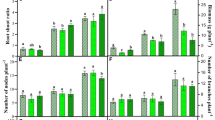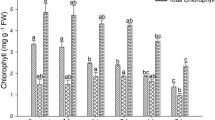Abstract
The UV-B-induced signals play a crucial role in improving the analeptic values of medicinally important plants. Eclipta alba L. (Hassak), commonly known as False Daisy, holds supreme stature with its pharmaceutical association in treating various ailments, particularly in Ayurvedic medicine. The present study aimed to evaluate the response of E. alba plants exposed to ambient (AT) and two different supplemental UV-B doses (eUV-B, ambient ±7.2 kJ m−2 day−1), i.e., intermittent (IT) and continuous (CT) UV-B treatment for 130 and 240 h respectively. Antioxidative activities and medicinally important compounds (wedelolactone) were measured in different plants’ parts at three growth stages. Under both the eUV-B treatments, the photosynthetic pigments were adversely affected (along with reductions in protein content) with a concomitant increase in secondary metabolites. Substantial variations in enzymatic antioxidants and non-enzymatic compounds showed the adaptive resilience strategies of plants against eUV-B. The wedelolactone content increased in leaves but compromised in stem and roots under IT. The results concluded that IT UV-B exposure led to the improvement of plant growth and the yield of wedelolactone compared to CT, suggesting its ameliorative role in improving the test plant’s medicinal value.








Similar content being viewed by others
Availability of data and materials
Not applicable
References
Alexieva V, Sergiev I, Mapelli S, Karanov E (2001) The effect of drought and ultraviolet radiation on growth and stress markers in pea and wheat. Plant Cell Environ 24(12):1337–1344. https://doi.org/10.1046/j.1365-3040.2001.00778.x
Bates LS, Waldren RP, Teare ID (1973) Rapid determination of free proline for water-stress studies. Plant Soil 39(1):205–207.
Beyer WF, Fridovich I (1987) Assaying for superoxide dismutase activity: Some large consequences of minor changes in conditions. Anal Biochem 161(2):559–566. https://doi.org/10.1016/0003-2697(87)90489-1
Bornman JF, Barnes PW, Robson TM, Robinson SA, Jansen MAK, Ballare CL, Flint SD (2019) Linkages between stratospheric ozone, UV radiation and climate change and their implications for terrestrial ecosystems. Photochem Photobiol Sci 18(3):681–716. https://doi.org/10.1039/c8pp90061b
Bradford MM (1976) A rapid and sensitive method for the quantitation of microgram quantities of protein utilizing the principle of protein-dye binding. Anal Biochem 72(1-2):248–254
Bray HG, Thorpe WV (1954) Analysis of phenolic compounds of interest in metabolism. Methods Biochem Anal 1:27–52
Britton C, Maehly AC (1955) Assay of catalase and peroxidase. In: Colowick, S.P., Kaplan, N.O., (ed.) Academic Press, New York. Methods in Enzymol 2:764–775
Chang CC, Yang MH, Wen HM, Chern JC (2002) Estimation of total flavonoid content in propolis by two complementary colometric methods. J Food Drug Anal 10(3):178–182
Coffey A, Prinsen E, Jansen MAK, Conway J (2017) The UVB photoreceptor UVR8 mediates accumulation of UV-absorbing pigments, but not changes in plant morphology, under outdoor conditions. Plant Cell Environ 40(10):2250–2260. https://doi.org/10.1111/pce.13025
Dai Q, Shaobing P, Chavez AQ, Vergara BS (1994) Intraspecific responses of 188 rice cultivars to enhanced UVB radiation. Environ Exp Bot 34(4):433–442. https://doi.org/10.1016/0098-8472(94)90026-4
Dalton DA, Russell SA, Hanus FJ, Pascoe GA, Evans HJ (1986) Enzymatic reactions of ascorbate and glutathione that prevent peroxide damage in soybean root nodules. Proc Natl Acad Sci 83(11):3811–3815. https://doi.org/10.1073/pnas.83.11.3811
Deikman J, Hammer PE (1995) Induction of anthocyanin accumulation by cytokinins in Arabidopsis thaliana. Plant Physiol 108(1):47–57
Douglas CJ (1996) Phenylpropanoid metabolism and lignin biosynthesis: from weeds to trees. Trends Plant Sci 1(6):171–178. https://doi.org/10.1016/1360-1385(96)10019-4
Dwivedi R, Singh VP, Kumar J, Prasad SM (2015) Differential physiological and biochemical responses of two Vigna species under enhanced UV-B radiation. J Radiat Res Appl Sci 8(2):173–181. https://doi.org/10.1016/j.jrras.2014.12.002
Elstner EF, Heupel A (1976) Inhibition of nitrite formation from hydroxylammoniumchloride: a simple assay for superoxide dismutase. Anal Biochem 70(2):616–620. https://doi.org/10.1016/0003-2697(76)90488-7
Fahey RC, Brown WC, Adams WB, Worsham MB (1978) Occurrence of glutathione in bacteria. J Bacteriol 133(3):1126–1129. https://doi.org/10.1128/jb.133.3.1126-1129.1978
Gitelson AA, Merzlyak MN, Chivkunova OB (2001) Optical properties and nondestructive estimation of anthocyanin content in plant leaves¶. Photochem Photobiol 74(1):38–45. https://doi.org/10.1562/0031-8655(2001)074<0038:opaneo>2.0.co;2
Hagh AG, Khara J, Darvishzadeh R (2012) Effect of UV-B radiation on activity of antioxidant enzymes in four sunflower cultivars. Int J Agric: Res Rev 2(5):528–534
Hamid A, Singh S, Agrawal M, Agrawal SB (2019) Heteropogon contortus BL-1 (Pilli Grass) and elevated UV-B radiation: the role of growth, physiological, and biochemical traits in determining forage productivity and quality. Photochem Photobiol 95(2):572–580. https://doi.org/10.1111/php.12990
Harding SA (2019) Condensed tannins: arbiters of abiotic stress tolerance? Tree Physiol 39(3):341–344. https://doi.org/10.1093/treephys/tpz005
Heath RL, Packer L (1968) Photoperoxidation in isolated chloroplasts. Arch Biochem Biophys 125(1):189–198. https://doi.org/10.1016/0003-9861(68)90654-1
Höll J, Lindner S, Walter H, Joshi D, Poschet G, Pfleger S, Ziegler T, Hell R, Bogs J, Rausch T (2019) Impact of pulsed UV-B stress exposure on plant performance: how recovery periods stimulate secondary metabolism while reducing adaptive growth attenuation. Plant Cell Environ 42(3):801–814. https://doi.org/10.1111/pce.13409
Hossain MA, Asada K (1984) Inactivation of ascorbate peroxidase in spinach chloroplasts on dark addition of hydrogen peroxide: its protection by ascorbate. Plant Cell Physiol 25(7):1285–1295. https://doi.org/10.1093/oxfordjournals.pcp.a076837
Kataria S, Jajoo A, Guruprasad KN (2014) Impact of increasing ultraviolet-B (UV-B) radiation on photosynthetic processes. J Photochem Photobiol B Biol 137:55–66. https://doi.org/10.1016/j.jphotobiol.2014.02.004
Keller T, Schwager H (1977) Air pollution and ascorbic acid. Eur J For Pathol 7(6):338–350. https://doi.org/10.1111/j.1439-0329.1977.tb00603.x
Khan T, Mazid M, Mohammad F (2012) A review of ascorbic acid potentialities against oxidative stress induced in plants. J Agrobiol 28(2):97–111. https://doi.org/10.2478/v10146-011-0011-x
Khomdram SD, Singh PK (2011) Polyphenolic compounds and free radical scavenging activity in eight Lamiaceae herbs of Manipur. Notulae Sci Biologicae 3(2):108–113
Król A, Amarowicz R, Weidner S (2014) Changes in the composition of phenolic compounds and antioxidant properties of grapevine roots and leaves (vitis viniferal.) under continuous of long-term drought stress. Acta Physiol Plant 36(6):1491–1499. https://doi.org/10.1007/s11738-014-1526-8
Kumar S, Dhanani T (2013) Development and validation of a rapid high performance liquid chromatography – photodiode array detection method for estimation of a bioactive compound wedelolactone in extracts of Eclipta alba. Braz J Pharm Sci 49(1):57–63
Kumari R, Singh S, Agrawal SB (2009) Combined effects of Psoralens and ultraviolet-B on growth, pigmentation and biochemical parameters of Abelmoschus esculentus L. Ecotoxicol Environ Saf 72(4):1129–1136. https://doi.org/10.1016/j.ecoenv.2008.12.009
Kumari R, Singh S, Agrawal SB (2010) Response of ultraviolet-B induced antioxidant defense system in a medicinal plant. Acorus calamus. J Environ Biol 31(6):907–911
Luo Q, Ding J, Zhu L, Chen F, Xu L (2018) Hepatoprotective effect of wedelolactone against concanavalin A-induced liver injury in mice. Am J Chin Med 46(04):819–833
Mosadegh H, Trivellini A, Ferrante A, Lucchesini M, Vernieri P, Mensuali A (2018) Applications of UV-B lighting to enhance phenolic accumulation of sweet basil. Sci Hortic 229:107–116. https://doi.org/10.1016/j.scienta.2017.10.043
Rai K, Agrawal SB (2017) Effects of Uv-B radiation on morphological, physiological and biochemical aspects of plants : an overview. In: J Sci Res 61:75–101
Rai K, Agrawal SB (2020) Effect on essential oil components and wedelolactone content of a medicinal plant Eclipta alba due to modifications in the growth and morphology under different exposures of ultraviolet-B. Physiol Mol Biol Plants 26(4):773–792. https://doi.org/10.1007/s12298-020-00780-8
Reyes-Díaz M, Meriño-Gergichevich C, Inostroza-Blancheteau C, Latsague M, Acevedo P, Alberdi M (2016) Anatomical, physiological, and biochemical traits involved in the UV-B radiation response in highbush blueberry. Biol Plant 60(2):355–366. https://doi.org/10.1007/s10535-015-0580-4
Rubio MC, González EM, Minchin FR, Webb KJ, Arrese-Igor C, Ramos J, Becana M (2002) Effects of water stress on antioxidant enzymes of leaves and nodules of transgenic alfalfa overexpressing superoxide dismutases. Physiol Plant 115(4):531–540. https://doi.org/10.1034/j.1399-3054.2002.1150407.x
Salama HMH, Al Watban AA, Al-Fughom AT (2011) Effect of ultraviolet radiation on chlorophyll, carotenoid, protein and proline contents of some annual desert plants. Saudi J Biol Sci 18(1):79–86. https://doi.org/10.1016/j.sjbs.2010.10.002
Sebastian A, Kumari R, Kiran BR, Prasad MNV (2018) Ultraviolet B induced bioactive changes of enzymatic and non-enzymatic antioxidants and lipids in Trigonella foenum-graecum L.(Fenugreek). The Euro Biotech J 2(1):64–71
Shailajan S, Menon S, Singh D, Swar G (2016) Validated analytical RP-HPLC method for quantitation of wedelolactone from Eclipta alba and marketed Ayurvedic formulations. Pharm J 8(2):132–139. https://doi.org/10.5530/pj.2016.2.6
Sharma A, Shahzad B, Rehman A, Bhardwaj R, Landi M, Zheng B (2019) Response of phenylpropanoid pathway and the role of polyphenols in plants under abiotic stress. Molecules 24(13):2452
Sieniawska E, Baj T (2017) Tannins. In: Pharmacognosy: Fundamentals, Applications and Strategy. Elsevier: Amsterdam, The Netherlands 199–232. https://doi.org/10.1016/B978-0-12-802104-0.00010-X
Syros T, Yupsanis T, Zafiriadis H, Economou A (2004) Activity and isoforms of peroxidases, lignin and anatomy, during adventitious rooting in cuttings of Ebenus cretica L. J Plant Physiol 161(1):69–77
Takshak S, Agrawal SB (2014a) Effect of ultraviolet-B radiation on biomass production, lipid peroxidation, reactive oxygen species, and antioxidants in Withania somnifera. Biol Plant 58(2):328–334. https://doi.org/10.1007/s10535-014-0390-0
Takshak S, Agrawal SB (2014b) Secondary metabolites and phenylpropanoid pathway enzymes as influenced under supplemental ultraviolet-B radiation in Withania somnifera Dunal, an indigenous medicinal plant. J Photochem Photobiol B Biol 140:332–343. https://doi.org/10.1016/j.jphotobiol.2014.08.011
Takshak S, Agrawal SB (2015) Defence strategies adopted by the medicinal plant Coleus forskohlii against supplemental ultraviolet-B radiation: augmentation of secondary metabolites and antioxidants. Plant Physiol Biochem 97:124–138. https://doi.org/10.1016/j.plaphy.2015.09.018
Takshak S, Agrawal SB (2016) Ultraviolet-B irradiation : a potent elicitor of phenylpropanoid pathway compounds. J Sci Res 60(January):79–96
Takshak S, Agrawal SB (2018) Interactive effects of supplemental ultraviolet-B radiation and indole-3-acetic acid on Coleus forskohlii Briq.: alterations in morphological-, physiological-, and biochemical characteristics and essential oil content. Ecotoxicol Environ Saf 147(August 2017):313–326. https://doi.org/10.1016/j.ecoenv.2017.08.059
Takshak S, Agrawal SB (2019) Defense potential of secondary metabolites in medicinal plants under UV-B stress. J Photochem Photobiol B Biol 193:51–88. https://doi.org/10.1016/j.jphotobiol.2019.02.002
Top SM, Preston CM, Dukes JS, Tharayil N (2017) Climate influences the content and chemical composition of foliar tannins in green and senesced tissues of Quercus rubra. Front Plant Sci 8(May). https://doi.org/10.3389/fpls.2017.00423
Tripathi R, Sarkar A, Pandey Rai S, Agrawal SB (2011) Supplemental ultraviolet-B and ozone: Impact on antioxidants, proteome and genome of linseed (Linum usitatissimum L. cv. Padmini). Plant Biol 13(1):93–104. https://doi.org/10.1111/j.1438-8677.2010.00323.x
Acknowledgements
The authors are very grateful to the Head, Department of Botany, Banaras Hindu University, for providing all the necessary laboratory facilities, Coordinator CAS in Botany, FIST (DST), and ISLS BHU. Special thanks to Council of Scientific and Industrial Research (CSIR), New Delhi, for the financial support in the form of a research project (CSIR\P-25\365). Kshama Rai is thankful to the Centre for Advanced Studies, Department of Botany, Banaras Hindu University, for the financial assistance.
Funding
This research was supported by the Council for Scientific and Industrial Research, New Delhi (CSIR), in the form of the research project (CSIR\P-25\365).
Author information
Authors and Affiliations
Contributions
K. R. collected, estimated, analyzed, and interpreted the experimental data. S. B. A. planned the experiment, and checked and evaluated the data and manuscript. All authors read and approved the final manuscript.
Corresponding author
Ethics declarations
Ethical approval
Not applicable
Consent to participate
Not applicable
Consent to publish
Not applicable
Competing interests
The authors declare no competing interests.
Additional information
Responsible Editor: Gangrong Shi
Publisher’s note
Springer Nature remains neutral with regard to jurisdictional claims in published maps and institutional affiliations.
Rights and permissions
About this article
Cite this article
Rai, K., Agrawal, S.B. An assessment of dose-dependent UV-B sensitivity in Eclipta alba: Biochemical traits, antioxidative properties, and wedelolactone yield. Environ Sci Pollut Res 28, 45434–45449 (2021). https://doi.org/10.1007/s11356-021-13963-x
Received:
Accepted:
Published:
Issue Date:
DOI: https://doi.org/10.1007/s11356-021-13963-x




